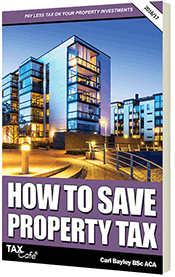Year End Tax Planning
For Property Investors
Will you be sheltered from rental tax this year?
WITH INTEREST rates so low, most property investors are now making rental profits. Some will be sheltered from tax this year, as they have accumulated enough losses in the past to cover their current profits.
Many, however, will have exhausted their earlier losses and will face big tax bills.
Example
Amanda has £2,000 of previously accumulated rental losses but expects to earn rental profits of £10,000 in the current tax year. She faces an income tax bill of up to £3,200 (£10,000 – £2,000 x 40%) unless she can carry out some year-end tax planning by 5th April.
So what can Amanda do? In practice there’s not much a buy-to-let investor can do to defer rental income, so most year-end tax planning revolves around accelerating expenses into the current tax year.
Generally speaking, three types of spending can be accelerated:
- Spending on the properties themselves
- Spending on the contents of the properties
- Other business expenses
When it comes to year-end tax planning, however, it is essential to only spend money on items that are tax deductible.
Spending on the Properties
If you spend money on your existing properties, the expense is normally treated as either a repair or an improvement.
From a tax planning perspective, repairs are good because they are immediately tax deductible and can save you up to 40% income tax.
Improvements are not so good because tax relief is only provided when the property is sold and will only save you 18% capital gains tax.
Obvious examples of repairs are things that require urgent attention: broken windows, leaking roofs, etc. This type of repair is normally dealt with by the landlord immediately so discretionary year-end tax planning doesn’t come into the picture.
Improvements are generally new features that were not present in the property before and therefore increase its value: extensions, attic conversions, etc.
Between these two extremes is a hybrid type of repair spending that will give you full income tax relief at up to 40% AND increase the value of your property.
This type of spending should be the focus of your year-end tax planning.
Examples include: New kitchens, new bathrooms, double glazing, re-wiring and most decorating costs.
Many property investors think of these items as improvements but they are in fact fully tax deductible repairs… providing you follow the rules.
To be treated as repairs it is important that you replace old items with new items and do not add something new that was not present before.
For example, replacing a tatty old kitchen is a tax deductible repair. If you add extra kitchen units or sockets, these additional items will be improvements.
Replacing a pea-green bathroom is a tax deductible repair. Installing a shower or downstairs toilet, where there wasn’t one before, is an improvement.
When replacing old items it is also important that you do not substantially upgrade the quality – that would be an improvement.
However, it IS acceptable to install items that are of superior quality when they are simply the nearest modern equivalent. For example, the taxman would not expect you to replace old single glazing with new single glazing when double glazing is the accepted modern standard.
Replacing MDF or similar kitchen units from the 1970s with MDF from 2010 would be a tax deductible repair. Replacing them with bespoke oak units would be an improvement.
The Landlord’s Energy Saving Allowance
Insulating a property is regarded as an improvement under basic principles. However, the landlord’s energy saving allowance allows you to claim immediate income tax relief for qualifying expenditure of up to £1,500 per rental property per tax year. Spending money on insulation by 5th April could knock up to £600 per property off your tax bill!
Property Contents
Like most landlords, Amanda is probably claiming the wear and tear allowance, which provides tax relief for the wear and tear on the contents of her properties: furniture, kitchen appliances, carpets, curtains, etc.
The allowance can be claimed every year and is generally 10% of gross rental income. It is not to be confused with ‘capital allowances’, which cannot usually be claimed on assets within residential letting properties.
If you claim the wear and tear allowance, you cannot claim any additional tax relief when you buy new items for your properties. So, if Amanda buys a new washing machine for one of her properties, she will not be able to claim any tax relief if she is also claiming the wear and tear allowance.
But landlords who use the alternative ‘renewals and replacements basis’ can claim a tax deduction when they buy new furniture, furnishings and equipment to go inside their properties – as long as the new items replace equivalent existing items.
When using the replacements basis, the replacement items are fully tax deductible in the year of purchase, so buying them by 5th April could be a useful way to reduce your tax bill this year.
Note that, if you are currently claiming the wear and tear allowance, you cannot switch to the renewals and replacements basis, or vice-versa. (If you want to check, look at Box 34 of the UK property section of your tax return.)
Commercial Property
Expenditure within commercial rental property (shops, offices, etc) or furnished holiday lettings (until 5th April 2010) qualifies for capital allowances. Qualifying items include heating, air conditioning, furniture and equipment. Expenditure of up to £50,000 each tax year will generally provide immediate 100% relief.
Other Business Expenditure
Expenditure on items within residential rental properties does not generally qualify for capital allowances, but you can still claim allowances on other items used for business purposes. Most landlords will get immediate 100% relief for expenditure on computers or office furniture used in their business. Relief is restricted if you also have some personal use of the assets, but it could still be worthwhile buying these items by 5th April.






